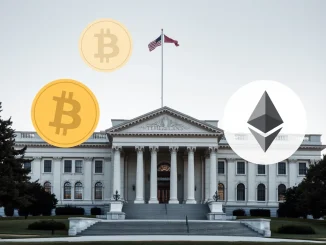
In the ever-evolving world of cryptocurrency, stablecoins have emerged as a cornerstone for stability and utility. Imagine a digital dollar that moves seamlessly across borders, powering decentralized finance (DeFi) and everyday transactions. That’s the promise of stablecoins. Now, a new startup called Codex is stepping into the limelight, armed with $15.8 million in seed funding, to build a stablecoin blockchain from the ground up. Let’s dive into why this is significant and what it means for the future of crypto.
Why a Blockchain Dedicated to Stablecoins?
You might be wondering, with so many blockchains already out there, why build another one specifically for stablecoins? The answer lies in optimization. Existing blockchains, while versatile, aren’t always perfectly suited for the unique demands of stablecoins. Codex aims to change that by creating a blockchain technology meticulously designed for stablecoin efficiency, stability, and scalability.
Think of it like this: you could drive a sports car to haul furniture, but a truck is simply better equipped for the job. Similarly, while stablecoins can operate on general-purpose blockchains, a dedicated infrastructure can unlock significant improvements. Codex envisions a future where stablecoin transactions are faster, cheaper, and more reliable than ever before.
Decoding the $15.8M Cryptocurrency Funding Round
Securing $15.8 million in seed funding is no small feat, especially in the current economic climate. This significant cryptocurrency funding round, led by Dragonfly Capital and backed by industry giants like Coinbase, Circle, and Wintermute, speaks volumes about the potential of Codex’s vision. Let’s break down why this funding is crucial and what it signals for the crypto space:
- Validation of the Vision: Major players in the crypto world are betting big on Codex. The participation of Coinbase and Circle, both deeply involved in the stablecoin ecosystem (Circle is the issuer of USDC), is a powerful endorsement.
- Fueling Innovation: This capital injection provides Codex with the resources to build a world-class team, develop cutting-edge technology, and accelerate the development of their specialized blockchain.
- Market Demand for Specialized Infrastructure: The funding highlights a growing recognition within the industry that dedicated infrastructure is essential for the continued growth and maturity of the stablecoin market.
Codex CEO Haonan Li, a former contributor to Optimism, brings valuable experience in scaling blockchain solutions. His background, combined with the robust financial backing, positions Codex strongly for success.
Enhancing DeFi Infrastructure with Optimized Stablecoin Blockchain
Stablecoins are the lifeblood of DeFi infrastructure. They provide the stability needed for lending, borrowing, trading, and various other decentralized applications. However, current blockchain limitations can sometimes hinder DeFi’s full potential. Codex’s optimized blockchain aims to address these challenges and unlock new possibilities for DeFi:
| Feature | Current Blockchains | Codex’s Optimized Blockchain |
|---|---|---|
| Transaction Speed | Can be slow and congested during peak times | Designed for high throughput and fast confirmations |
| Transaction Costs | Gas fees can fluctuate and become expensive | Optimized for lower and more predictable transaction fees |
| Stability & Reliability | General-purpose blockchains may experience network instability | Engineered for robust stability and uptime, crucial for stablecoin operations |
| Customization | Limited customization for specific stablecoin needs | Tailored features and functionalities designed specifically for stablecoins |
By focusing solely on stablecoins, Codex can fine-tune its blockchain to overcome the bottlenecks that sometimes plague general-purpose networks. This could translate to a more seamless and efficient DeFi experience for users.
What Does an Optimized Blockchain Actually Mean?
The term “optimized blockchain” might sound technical, but the core concept is straightforward: building a blockchain with a laser focus on specific goals. In Codex’s case, this means designing a network that prioritizes the characteristics most important for stablecoins:
- Scalability: Handling a massive volume of stablecoin transactions efficiently.
- Low Latency: Ensuring transactions are processed and confirmed quickly.
- Cost-Effectiveness: Minimizing transaction fees to make stablecoin usage accessible.
- Security: Maintaining a robust and secure network to protect stablecoin holders.
- Interoperability: Facilitating seamless interaction with other blockchains and DeFi platforms.
Codex’s approach could pave the way for a new generation of blockchains that are purpose-built for specific applications, moving beyond the “one-size-fits-all” model. This specialization could lead to significant advancements in various areas of the crypto and Web3 space.
The Future is Stable: What to Expect from Codex?
Codex is still in its early stages, but the $15.8 million seed round and the backing of prominent investors indicate a bright future. As they build their optimized blockchain, we can expect to see:
- Increased Efficiency in Stablecoin Transactions: Faster and cheaper transfers, potentially impacting everything from remittances to everyday payments.
- Enhanced DeFi Ecosystem: A more robust and scalable infrastructure for DeFi applications, leading to greater innovation and adoption.
- Potential for New Stablecoin Use Cases: With improved performance, stablecoins could expand into new areas and industries.
- Competition and Innovation: Codex’s project could spur further innovation in blockchain technology, encouraging others to explore specialized solutions.
The journey to build a revolutionary blockchain is a marathon, not a sprint. However, Codex has taken a significant first step. Keep an eye on this startup as they work to build the infrastructure that could power the next wave of stablecoin adoption and DeFi growth. The future of stablecoins might just be getting a whole lot more stable, thanks to Codex.



